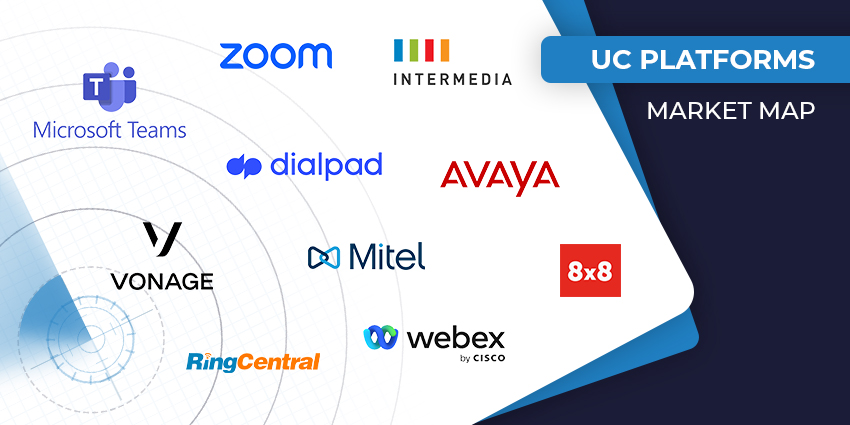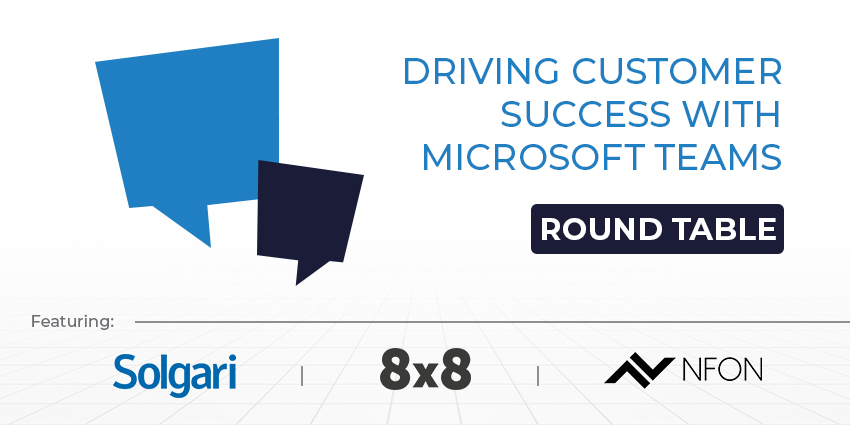If you’re responsible for choosing the best UC platforms for your business, you already know the stakes. You’re not just choosing a PBX system anymore. You’re investing in an all-in-one ecosystem of channels, tools, and integrated AI assistants, built to supercharge your team.
Unified communications has become the backbone of daily operations in many companies, especially if you’re supporting remote or hybrid teams. But the truth is, picking the right platform isn’t simple. The market is huge (expected to be worth $417.86 billion by 2030), and the playing field is stacked.
Every market report gives you a different opinion. This guide is here to clarify the confusion, with real objective insights into what the top players in UC really have to offer.
Some of these platforms have been around for decades and evolved alongside big enterprises. Others are newer names that have grown fast by simplifying how teams connect. Whether you care most about security, integrations, cost control, or user experience, you’ll see straight away which options deserve a closer look.
The Best UC Platforms:
- 8×8
- Avaya
- Webex by Cisco
- Dialpad
- Intermedia
- Microsoft Teams
- Mitel
- RingCentral (MVP)
- Vonage
- Zoom (One)
The Best UC Platforms in 2025: Meet the Comms Champions
We’re focusing on the vendors that have proven staying power and clear momentum going into this year. Each of these vendors has earned a place on this list of the best UC platforms for their technology’s impact, potential, and innovation factor.
Let’s get into the details and see which of these top UC solutions can actually deliver on what matters most to your teams.
8×8
8×8 has been around long enough to know that most companies don’t want five different tools stitched together. So they’ve kept expanding their platform to cover everything in one place: calls, video, chat, and even contact center.
8×8 cleans things up on the admin side too, with analytics dashboards that pull together call quality, usage trends, and customer engagement in one place. Plus, AI is integrated into every collaborative experience, from video calls to chat threads.
One thing that sets 8×8 apart is how much of the world it covers natively. The platform offers local phone numbers and compliance support in over 50 countries, with Machine-Learning enhanced “Global Reach” which can be a big plus for companies with distributed offices.
8×8 has kept expanding integrations too, so it connects with CRM systems and collaboration apps that many teams already rely on. For those who need to expand, extend, or customize, there are APIs for things like SMS and chat.
Avaya
Avaya’s been a fixture in enterprise phone systems for decades. You’ll probably struggle to find any list ranking the best UC platforms that doesn’t mention them. Like most leaders, Avaya is carefully moving enterprise customers toward a more cloud-friendly approach without telling everyone to rip out their old gear.
Their main UC offering, Avaya Cloud Office, tries to strike that balance, with tailored cloud migration paths, simple administration, and device-agnostic performance. Embedded AI is a standard part of the package, alongside integrations for any tools you might already use.
Teams can personalize everything from call routing and transcription rules to cloud connectivity options. Plus, automatic maintenance provides businesses with constant upgrades without manual intervention.
Webex by Cisco
A lot of people still think of Webex as the old-school web meeting tool. These days, it’s grown into something much bigger. Cisco has turned Webex into a full communications suite with calling, chat, video, whiteboarding, the works. They’ve also been adding AI features faster than most competitors. Real-time transcription, automatic meeting summaries, live translation, and more.
Unlike some of the other best UC platforms, Webex also supports integrations with customer experience tools, webinar and event systems, and even asynchronous video messaging apps. Plus, Webex stands out in hardware integrations.
If you already run Cisco devices in your offices, the experience can feel seamless. The management portal, Webex Control Hub, shows teams what’s happening across your environment without the need to click through a maze of settings.
Dialpad
Dialpad focuses more on customer experience and CCaaS than most of the companies on this list, but its enterprise-grade UC platform, with AI-powered meeting software, presence features, device-agnostic performance, and messaging still stands out.
One of the more modern, cloud-native UC platforms out there, Dialpad’s system runs on the company’s own backend, and you can tell. AI is a big focus for the company too, with assistants that can summarize, transcribe, translate, and clean up meetings in real time.
The platform integrates with various apps, from Salesforce to Zendesk. If you want to build your own custom integration, you can, with a flexible API. Plus, you get real-time insights into call volume, usage, and adoption across global offices.
Intermedia
Cloud IT application provider Intermedia offers the Intermedia Unite solution for communication and collaboration. The platform supports business phone capabilities with over 90 features, including unlimited domestic calling and HD voice.
It also enables video conferencing, team chat capabilities, and cloud-based file management. There’s automated data capture for compliance, powerful contextual search features, and apps for mobile devices and desk phones. Users can access integrations with their favorite business tools and contact center systems, set up auto-attendants, and leverage comprehensive presence insights.
Plus, Intermedia offers powerful administration tools, analytics capabilities, and triple shield security to help keep teams safe and compliant wherever they communicate.
Microsoft Teams
Teams has become so common in the enterprise world that it’s almost shorthand for collaboration. If you’re already using Microsoft 365, there’s a good chance Teams is woven into your daily workflows, which is why it’s ended up as the best UC platform choice for so many organizations.
Teams has evolved quickly. Built-in calling plans and carrier connection options have turned it into a credible phone system replacement. Over time, Microsoft has tightened integrations between Teams and other apps like Outlook, SharePoint, and OneDrive, so messages, meetings, and documents all live in the same space.
Microsoft Teams also includes XR features like Microsoft Mesh and Immersive Spaces for meetings and AI support from Copilot for Teams. This allows companies to summarize meetings and messages, access support in the flow of work, and even improve scheduling strategies. Additionally, Teams also integrates with a huge range of other business apps and tools.
Mitel
Offering on-site and cloud-based communications solutions, Mitel supports companies in over 100 countries with extensive UC solutions. There are various options to choose from, such as the OpenScape UC system for mobility and federated presence, or MiCollab, fully integrated with Microsoft Teams and designed to bring teams together.
There’s even the Unify Phone system – the hybrid solution for companies not quite ready to take the full leap into the cloud. Whatever you choose, you can expect global reach, flexible and modular components, and advanced call controls.
Mitel offers a selection of advanced UC and CX solutions too, intended for companies ready to bridge the gaps between communication workflows.
RingCentral RingEx
RingCentral is one of the biggest names in cloud communications, and for good reason. The RingEx platform is built to cover nearly every angle: voice, messaging, video meetings, fax, and integrations with a long list of business apps. Over the past year, RingCentral has been adding more AI-powered features, including smart meeting summaries and upgraded analytics dashboards to help teams see what’s working and where to improve.
One thing a lot of companies appreciate is how quickly you can get up and running. There’s not much to install locally, and the interface is clean enough that most employees pick it up without much training. RingCentral also offers a broad range of international phone numbers and carrier relationships, which comes in handy if you operate across different regions.
The platform keeps expanding integrations too, so it connects with CRM systems, productivity suites, and help desk tools.
Vonage
Vonage has steadily evolved from its early days as a VoIP provider into one of the best UC platforms for companies that want more than just calling. The Vonage Business Communications suite brings together voice, video meetings, messaging, and a library of APIs that can embed communications into your own apps and workflows.
Companies get a 99.999% uptime guarantee, end-to-end security and encryption, and a fully customizable turnkey experience. One thing that makes Vonage stand out is its developer focus. If you want to build custom integrations or automate parts of your customer experience, the API platform is mature and widely used. For teams that prefer an out-of-the-box experience, everything is also available in one app without extra setup.
Vonage also offers mobile apps for its UC platform, a comprehensive admin portal for team management, and AI tools like the AI virtual assistant to add intelligence to any conversation.
Zoom Workplace
Zoom has proven it can do a lot more than video meetings with Zoom Workplace. The all-in-one ecosystem combines team chat, VoIP telephony, email and calendaring tools, and virtual working spaces in one straightforward portal. It also includes an appointment scheduling solution and an online whiteboard for creative collaboration.
Like many of the best UC platforms, Zoom is AI-first, with an integrated AI companion that’s accessible in every Zoom app. The platform has workspace reservation tools for hybrid teams and robust integrations with a range of apps, devices, and room systems.
Companies can also connect their UCaaS system with Zoom’s tools for workforce engagement, sales, and customer experience management.
Ready to Move Your UC Plans Forward?
If you’re starting to dig into UC platforms, or even just thinking about it, you’re definitely not alone. It can feel pretty overwhelming fast. There are so many companies claiming to offer the “best UC platforms” right now. But you don’t have to figure everything out alone.
We’re here to be your trusted guide, always on hand to help you navigate vendor options, market dynamics, and the latest data.
Here’s how we can help you take your next step:
- Dive into the data: Download our latest research reports for exclusive insights into UC market trends, vendor performance, and what’s next for communication.
- Connect with the community: Join our UC community to hear real-world stories from IT leaders, decision-makers, and collaboration champions.
- Experience innovation first-hand: Check out upcoming industry events where you can meet vendors face-to-face, see live demos, and build your network.
- Plan your buyer roadmap: When you’re ready to buy, our UC Buyer’s Guide will walk you through every stage of the process, from gathering requirements to implementation.
The way people work together is changing fast, and having the right UC setup can make a huge difference. It’s not just about how your teams talk to each other—it’s about how work actually feels day to day. We’re here to help you get the information you need to make choices that really move things forward.







